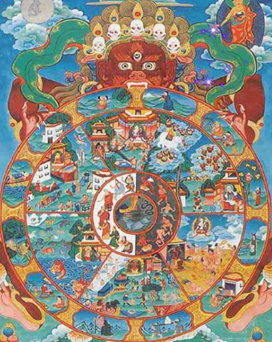examn questions buddhism
1/44
There's no tags or description
Looks like no tags are added yet.
Name | Mastery | Learn | Test | Matching | Spaced |
|---|
No study sessions yet.
45 Terms
What is meant by “reactions against the Vedic traditions”? Who reacted, and against what?
Provide some examples.
Discuss aspects of the early spread of Buddhism.
Comment on the image of Sanchi, Stūpa 1. More generally, what is the significance of stūpas/relics?

Shortly explain the impact of King Ashoka on the early development of Buddhism.
In class we discussed “Southern” and “Northern” traditions of Buddhism. Can you elaborate on
this?
Shortly discuss the Kuṣāṇa Empire and the significance of the Gandhāra region for the spread of Buddhism.
Explain the terms Theravada, Mahayana, and Vajrayana. Where would you geographically
locate these types of Buddhism?
Please discuss the terms “Śākyamuni Buddha”, “Pratyekabuddha”, and “arhat”. What can “bodhisattva” refer to?
Can you remember some sites / locations important in the life of the Buddha?
Please explain the term “jātaka”. Can you give some examples?
Discuss approaches to the “absence of the Buddha”.
We have encountered the term “dharma” in various contexts. Please explain!
Discuss aspects of the cult of relics in Buddhism.
Do you recall some family members of Śākyamuni? Can you give an example of a story in which they feature?
Discuss the legends concerning the birth of the Buddha (conception, birth, Māyā’s dream,...)
Discuss narratives concerning Buddha’s life in the palace and the Four Encounters.
Discuss the temptation of Māra and Buddha’s enlightenment.
According to tradition, what were the main teachings of Buddha during his first sermon. How is the first sermon usually indicated in Buddhist iconography?
Shortly discuss the role of languages in the transmission of Buddhism. What are the languages
of the existing Buddhist canons?
In class we discussed that several of Buddha’s basic doctrines are related to important events in his life. Can you give (an) example(s)?
“Middle Way” is one of the central concepts of Buddhism, and it was interpreted in various ways. Please elaborate!
Explain the doctrines of non-self (anātman).
Explain the significance of the 12-fold chain of dependent arising. Can you remember the links
in this chain.
“Rebirth” was always a problematic term in Buddhism. Can you give some examples of the
discourse concerning this term? What role does “karma” play?
How do different schools explain “karma”?
Shortly discuss some basic ethical notions in Buddhism. Why is it important to behave ethically (trying “to be good”)?
Discuss the term “Five Skandhas”.
Discuss the notion of “continuity” (or the lack of it) in terms of rebirth. How does the term
ālayavijñāna relate to that?
Discuss the Four Noble Truths.
Please decipher this “chakra” / wheel of life (image).

Discuss the Eightfold Path and its relation to the threefold moral teaching.
What happened during the synodes / Buddhist councils?
Shortly discuss the standpoints of the Sthaviravādins and Mahāsāṃghikas.
Shortly discuss the development of the Sarvāstivāda school.
Discuss some central concepts of Mahāyāna Buddhism.
Discuss the central Mahāyāna term śūnyatā.
Why is a bodhisattva in a “paradoxical” situation?
Discuss the different “types” of bodhisattvas. Which ones had a special impact in East Asia?
Can you remember some of the Mahāyāna scriptures we discussed in class? You should
remember at least three.
Shortly discuss the main ideas of the Madyāmaka School.
Which school promotes the concept of “consciousness only”. What is the idea behind this?
- Discuss the Lotus sutra and its significance in East Asia.
- Discuss some important narratives / parables of the Lotus sutra and what Mahāyāna
teachings they reflect.
Shortly discuss Maitreya and the ideas related to this figure.
Do you remember some of the “celestial” bodhisattvas and their functions?
Can you mention some Chinese and/or Japanese Buddhist schools and define some of their
characteristics?